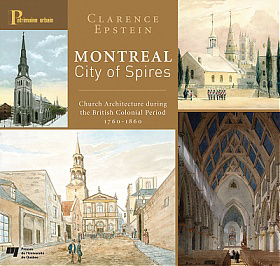New book traces Montreal's urban evolution

This is the first time I was ever in a city where you couldn't throw a brick without breaking a church window!” So proclaimed Mark Twain when he visited Montreal in 1881. Nearly two centuries later, such illustrious visitors would be hard pressed hit their target given that precious few examples of religious architecture remain standing.
For Clarence Epstein, director of Special Projects and Cultural Affairs at Concordia University, the receding number of steeples on the skyline belies the fact that the city was at one time the chief outpost of Catholicism in the New World as well as the shining jewel in England’s imperial crown – as paradoxical as that may seem.
His new book, Montreal, City of Spires: Church Architecture during the British Colonial Period 1760-1860, harkens back to a time when these places of worship were what he refers to as “strategic public spaces, meeting places and power bases.”
Published as part of the Urban Heritage series by the Presses de l'Université du Québec, this tome provides in-depth research and never-before-published images of 50 structures built in the century following the British conquest of New France.
This urban evolution’s account begins with the remarkable series of transformations that took place in what was a small Catholic trading post. Epstein traces the city’s transformation into a bastion for many English-speaking communities during the decades leading up to Confederation, as Montreal’s population surged.
By examining the social, religious and architectural issues surrounding these British-era structures, Epstein addresses the complexities in Montreal’s historiography. “As eclectic as many of these places of worship are in appearance, they reflect our unique makeup,” he says. “While it stands to reason that built forms evolve in tandem with civic needs, these churches, and synagogues for that matter, are testaments to the overlapping histories of our many founding communities.”
“The course of this architectural development is critical to understanding our civic and national identities,” Epstein continues. “This is a city in which correlations between power, community and language define the urban scene — and that is reflected in the contributions of many of the groups who once resided here, and some of those who continue to reside here. Montrealers depend on their proximity to one another, collectively enhancing the city’s character often because of their socio-religious differences. One could say that Montreal is the mother house of the Canadian cultural experience.”
Epstein will be participating in an upcoming two-day symposium on Criminality in the Art and Cultural Property World:
- Friday and Saturday, June 15 and 16, 2012
- Osgoode Hall, 130 Queen St. W., Toronto
- Learn more
Related links
- Montreal, City of Spires: Church Architecture during the British Colonial Period 1760-1860
- Presses de l’Université du Québec
- Fast facts from City of Spires

